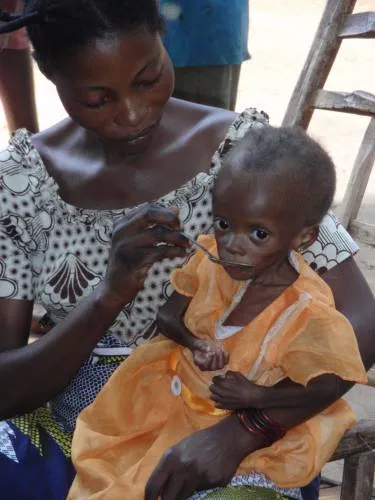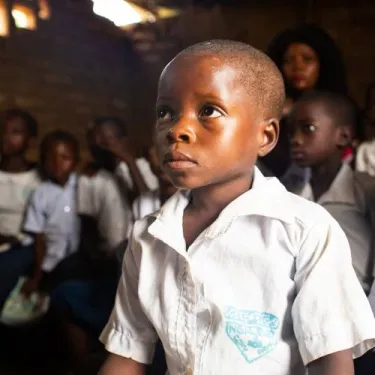What Will Endure?
A Letter from Larry and Inge Sthreshley, serving in Congo
Spring 2022
Dear friends,
“What will endure?” That was the prevailing question throughout a recent farewell trip Larry took with IMA team members and representatives from the British government’s Foreign Commonwealth & Development Office (FCDO) to the Kasai Central Province. The ASSR project, which stands for Support to the Health System of the Democratic Republic of Congo, ended on April 25th. It marks the end of nine years of health system strengthening support for the Nord Ubangi and the Kasai Central Provinces by FCDO.
The delegation met with Dr. Eugénie Misenga, a dynamic woman and the director of the provincial health district of the Kasai Central. In their exchange, she commented that it was because of the training she received through FCDO when she was a health zone director that she was able to do her job. She stated, “Without that training, I would never have known the answers to the questions I was asked to get this job. I would not have this job and be serving this population.” She regretted that FCDO and IMA World Health were leaving the province and thanked them for their assistance over all these years.
After the customary visit to the provincial office, Larry and the delegation went to Nkufulu health center in Ndesha health zone, a peri-urban area of Kananga. At the beginning of the project nine years ago, they were only seeing 15–20 patients a month, but now the nurse proudly explained that they are seeing 860 patients a month. This was a result of working with each health zone to lower and standardize prices at all the health centers. In return, the health centers received a subsidy of medicines, equipment, and training from the project. As a result, more people could afford to seek care at the health centers because of the lower prices and when they did so, they received better treatment because the health centers were stocked with essential medicines, equipment, and nurses had received regular training and supervision. This, in turn, created more demand. The utilization of health centers nine years ago was 34%; now, it is 71%.

When asked what would endure after the project, the response was consistently, “The good health centers that you built and the training we received. What we have learned will endure”. At one health center, the nurse said explicitly, “our nutrition program.” “You have taught us how to prevent malnutrition and treat malnourished children with local foods. We don’t have to wait for an outside program to help us.”
Some of you may remember the story of Mado I wrote about in an earlier newsletter, who was severely malnourished as a toddler. We were doing a training in Ndesha health zone on how to make an enriched porridge, and I had asked to do the demonstration at the home of a malnourished child. When we entered the yard at Mado’s home, I was not prepared for how malnourished she was at the time. But we went ahead and did the cooking demonstration. Weeks later, when we heard she had recovered and I received a picture of her, I was ecstatic. The change was so dramatic. On Larry’s last trip, one of the team members wanted to follow up on Mado and went to her home, only to find out she wasn’t there. She was in school! Here is a beautiful picture of that same little girl, previously severely malnourished, now several years older and in school. Her story has been shared by video in our trainings and has inspired thousands of families to try using a homemade enriched porridge to treat their malnourished child or keep their healthy children well nourished. Since the ASSR project started in April 2019, over 540,000 malnourished children have received five home visits by a trained community health volunteer and recovered.

The number of children screened for malnutrition each quarter has increased from 21% in 2019 to an average of 92%. Approximately 1,500,000 children between six months and five years of age are being screened quarterly by community volunteers and members of the young mother support groups. Since 2019, the overall prevalence rate for acute malnutrition has dropped from 6.4% to 2.2 % in Nord Ubangi province, from 17.5% to 3.1% in Kasai Central and from a high of 13% to 7.2% in Kasai Province.
Nutrition wasn’t initially an activity of the Access to Primary Health Care (ASSP) project. It was added later, yet it became one of the most impactful components of the ASSP and ASSR projects! It is with mixed emotions that we have said goodbye to the people in the local organizations we have worked with, like the Program de Development du Kasai (PRODEK) in Kasai Central and Commuanté Evangelique de la Mongala (CEUM) in Nord Ubangi. Yet I know we have left them and the health center staff with the knowledge and the tools they need to continue in the challenge to lower malnutrition in the communities they serve.
For those of you who have been supporting us through your prayers and financial gifts since the beginning of this journey in 2013 or who have joined us along the way, we say thank you! Your support has made a life-changing difference for so many people in the Congo. We look forward to your continued support and to what God has in mind for us to do next in Congo.
Blessings,
Inge Sthreshley
